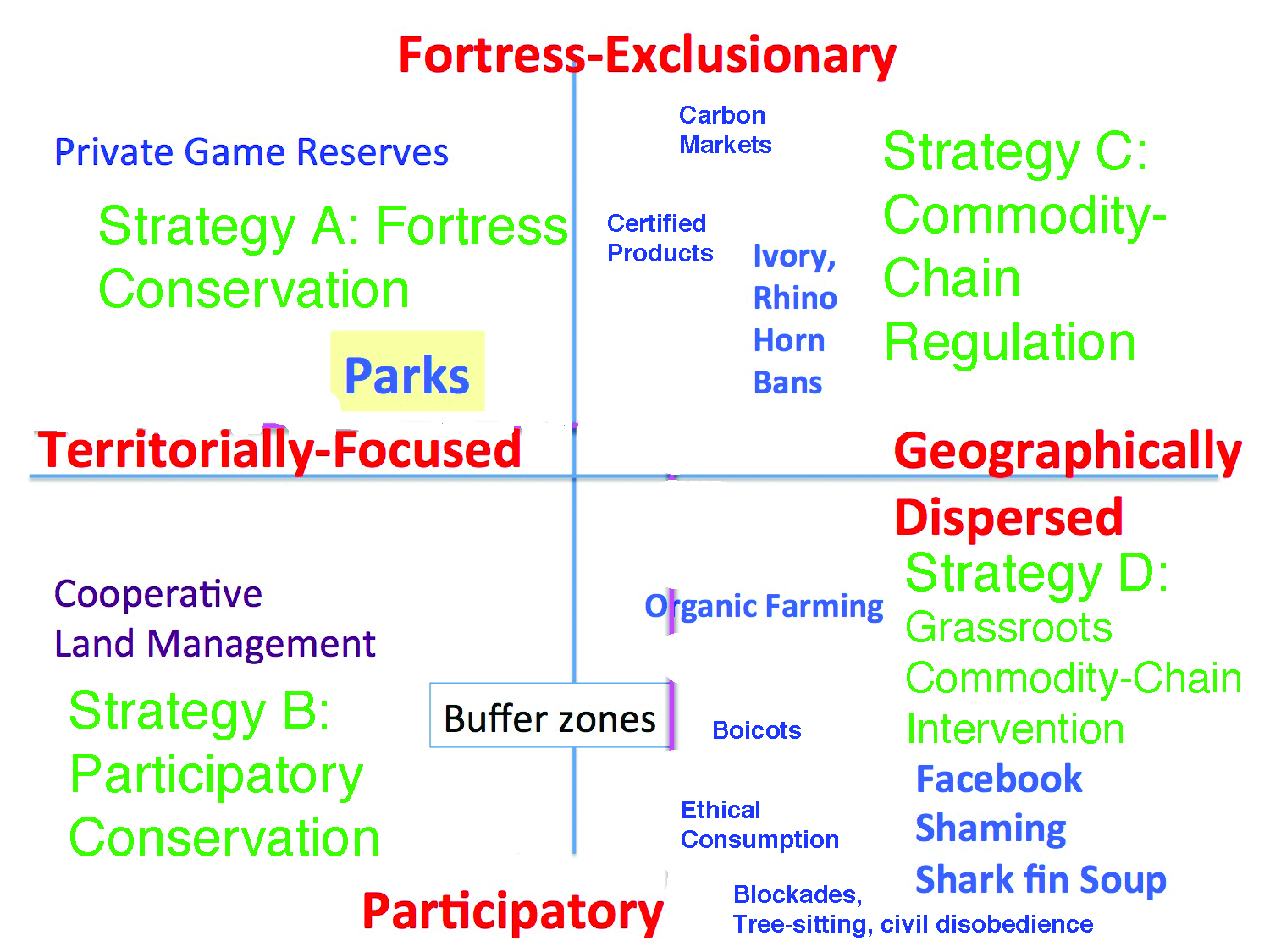Part II: Environmental Issue Response: Two Strategies
Strategies: Choose TWO strategies, drawn from TWO DIFFERENT AREAS from the Diagram below (as discussed in class). Describe your strategies in detail and explain how they will function to resolve or meliorate your environmental issue.
Design a Multi-Prong Using TWO of the FOUR approaches DESCRIBED IN CLASS (i. Exclusionary Territorial, ii. Exclusionary non-Territorial, iii. Participatory Territorial, iv. Participatory Non-Territorial)

Page 1
Cover Sheet
Title Page: Place, People, YOUR NAME,
Date, Section,
Geographical Coordinates of project site
environmental issue or concern: Same As Part I, if you make any changes you need to clear these with your TA first!
Locator Map (Good source: UT Map Library): WITH COORDINATES PINPOINTED ON MAP
Environmental Issue or Concern: This will be the same as in Project Part 1, unless you have made other arrangements with your TA.
Page 2
Strategy 1
First Strategy: Pick one of the four strategies (A, B, C or D) on the chart above and explain how you will use it to resolve the environmental issue that you identified in Project part 1. Your answer should be based upon the relevant lectures, readings, and discussion section presentation:
See below for details relevant to strategies A-D.
Please cite the relevant sources when explaining your strategy.
Pg. 3
Strategy 2
This second strategy MUST COME from a different area on the diagram above: for example, if you selected a strategy based upon Area A, then you will need to devise a second strategy based upon relevant materials from Areas B, C or D.
See below for details relevant to strategies A-D.
Please cite the relevant sources when explaining your strategy.
Page 4:
Addenda: Map and Commodity chain diagrams, as needed
Both of these should fit on the same page (if you combine dispersed and territorial strategies)
i. Map of Reserve -- if using a territorial strategy as one of your two strategies
ii. Commodity-chain diagram -- if using a dispersed strategy as one of your two strategies
Pg. 5
Combining Strategies
Conclude your project by discussing how these two strategies might work together to achieve a better outcome than an approach relying on a single strategy. Be sure to address ethical concerns in your final paragraph.
For instance, in what ways might your solutions, even in combination, create problems for the people that you discussed in the first part of your semester project? Be specific and refer back to your Part 1 assignment
Page 6
Bibliography
The expectation is that you provide at least 1 additional source for each strategy (2 additional sources in all) to explicate the environmental strategies or effects on people -- for instance in discussing who will be affected, territorial or commodity-chain issues, and examples (e.g., of boycotts, ethical product markets, regulatory approaches, etc.).
Strategy A: Exclusionary/territorial
Fortress Conservation
State that you are applying a 'Fortress Conservation' strategy and provide a map showing where your reserve is going to be located.
Explain why your environmental issue merits an exclusionary reserve, state how the reserve is going to be financed, and explain what will happen to the people who are excluded from the area.
Strategy B: Participatory/territorial
Participatory Conservation
State that you are applying a 'Participatory Conservation' strategy and provide a map showing where your reserve is going to be located.
Explain why your environmental issue will benefit from a participatory reserve, state how the reserve is going to be managed -- and financed if necessary. Identify conflicts that may occur as a result of the reserve (either within the group or between the reserve and outsiders) and say how these might be resolved. CITE scholarly sources, as discussed in class for the first part of your project.
Strategy C: Exclusionary/dispersed
Regulating Commodity-Chains
State that you are applying a 'Dispersed Regulatory' strategy and draw a commodity-chain diagram that pinpoints the site at which your regulatory strategy will intervene.
Explain why your environmental issue will benefit from a regulation, explain how the regulation is going to be applied (e.g., through police action, via a cap-and-trade market, or through a certification process). Note points of inspection or policing and identify at least one issue that may arise and how it would be addressed.
Strategy D: Participatory/dispersed
Grassroots Intervention in Commodity-Chains
State that you are applying a 'Participatory Dispersed' strategy and draw a commodity-chain diagram that pinpoints the site at which your group will intervene.
Explain why your environmental issue will benefit from participatory intervention, explain what sort of intervention you will undertake (e.g., boycott, environmental product marketing or production such as organic agriculture, blockades and civil disobedience, facebook shaming) and how this will help to resolve the environmental issue. Identify at least one issue that may arise and explain how it would be addressed.